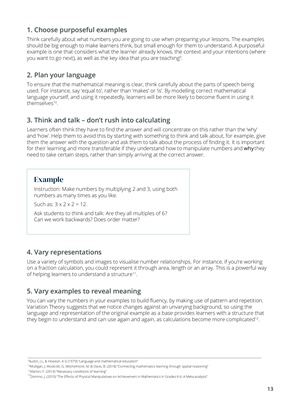
13
1. Choose purposeful examples
Think carefully about what numbers you are going to use when preparing your lessons. The examples
should be big enough to make learners think, but small enough for them to understand. A purposeful
example is one that considers what the learner already knows, the context and your intentions (where
you want to go next), as well as the key idea that you are teaching9.
2. Plan your language
To ensure that the mathematical meaning is clear, think carefully about the parts of speech being
used. For instance, say 'equal to', rather than 'makes' or 'is'. By modelling correct mathematical
language yourself, and using it repeatedly, learners will be more likely to become fluent in using it
themselves10.
3. Think and talk - don't rush into calculating
Learners often think they have to find the answer and will concentrate on this rather than the 'why'
and 'how'. Help them to avoid this by starting with something to think and talk about, for example, give
them the answer with the question and ask them to talk about the process of finding it. It is important
for their learning and more transferable if they understand how to manipulate numbers and why they
need to take certain steps, rather than simply arriving at the correct answer.
4. Vary representations
Use a variety of symbols and images to visualise number relationships. For instance, if you're working
on a fraction calculation, you could represent it through area, length or an array. This is a powerful way
of helping learners to understand a structure11.
5. Vary examples to reveal meaning
You can vary the numbers in your examples to build fluency, by making use of pattern and repetition.
Variation Theory suggests that we notice changes against an unvarying background, so using the
language and representation of the original example as a base provides learners with a structure that
they begin to understand and can use again and again, as calculations become more complicated12.
Example
Instruction: Make numbers by multiplying 2 and 3, using both
numbers as many times as you like.
Such as: 3 x 2 x 2 = 12.
Ask students to think and talk: Are they all multiples of 6?
Can we work backwards? Does order matter?
9Austin, J L, & Howson, A G (1979) "Language and mathematical education"
10Mulligan, J, Woolcott, G, Mitchelmore, M, & Davis, B. (2018) "Connecting mathematics learning through spatial reasoning"
11Marton, F. (2014) "Necessary conditions of learning"
12
Domino, J. (2010) "The Effects of Physical Manipulatives on Achievement in Mathematics in Grades K-6: A Meta-analysis"